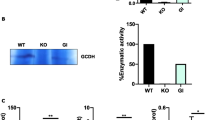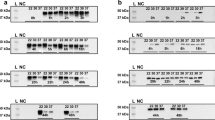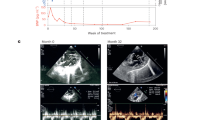Abstract
Glutaryl-CoA dehydrogenase (GCDH) deficiency causes glutaric aciduria type I (GA I), an inborn error of metabolism that is characterized clinically by dystonia and dyskinesia and pathologically by neural degeneration of the caudate and putamen. Studies of metabolite excretion allowed us to categorize 43 GA I Spanish patients into two groups: group 1 (26 patients), those presenting with high excretion of both glutarate and 3-hydroxyglutarate, and group 2 (17 patients) , those who might not be detected by routine urine organic acid analysis because glutarate might be normal and 3-hydroxyglutarate only slightly higher than controls. Single-strand conformation polymorphism (SSCP) screening and sequence analysis of the 11 exons and the corresponding intron boundaries of the GCDH gene allowed us to identify 13 novel and 10 previously described mutations. The most frequent mutations in group 1 were A293T and R402W with an allele frequency of 30% and 28%, respectively. These two mutations were also found in group 2, but always in heterozygosity, in particular in combination with mutations V400M or R227P. Interestingly, mutations V400M and R227P were only found in group 2, and at least one of these mutations was found in 11 of 15 unrelated alleles, accounting together for 53% of the mutant alleles in group 2. Therefore, it seems clear that two genetically and biochemically distinct groups of patients exist. The severity of the clinical phenotype seems to be closely linked to the development of encephalopathic crises rather than to residual enzyme activity or genotype. Comparison of GCDH protein with other acyl-CoA dehydrogenases (whose x-ray crystal structure has been determined) reveals that most of the mutations identified in GCDH protein seem to affect folding and tetramerization, as has been described for a number of mutations affecting mitochondrial β-oxidation acyl-CoA dehydrogenases.
Similar content being viewed by others
Log in or create a free account to read this content
Gain free access to this article, as well as selected content from this journal and more on nature.com
or
Abbreviations
- GA I:
-
glutaric aciduria type I
- GCDH:
-
glutaryl-CoA dehydrogenase
- FAD:
-
flavin adenine dinucleotide
- ETF:
-
electron-transfer flavoprotein
- GC-MS:
-
gas chromatography-mass spectrometry
- MCAD:
-
medium-chain acyl-CoA dehydrogenase
- SCAD:
-
short-chain acyl-CoA dehydrogenase
- VLCAD:
-
very-long-chain acyl-CoA dehydrogenase
- IVD:
-
isovaleryl-CoA dehydrogenase
- SSCP:
-
single-strand conformation polymorphism
References
Goodman SI, Frerman FE 1995 Organic acidemias due to defects in lysine oxidation: 2-ketoadipic acidemia and glutaric acidemia. In: Scriver CR, Beaudet AL, Sly WS, Valle D (eds) The Metabolic and Molecular Bases of Inherited Disease, 7th Ed. McGraw-Hill, New York, 1451–1460.
Superti-Furga A, Hoffman G 1997 Glutaric aciduria type I (glutaryl-CoA dehydrogenase deficiency): advances and unanswered questions. Eur J Pediatr 156: 821–828.
Baric I, Zschocke J, Christensen E, Duran M, Goodman SI, Leonard JV, Müller E, Morton DH, Superti-Furga A, Hoffmann GF 1998 Diagnosis and management of glutaric aciduria type I. J Inherit Metab Dis 21: 326–340.
Hoffmann GF, Zschocke J 1999 Glutaric aciduria type I: from clinical, biochemical and molecular diversity to successful therapy. J Inherit Metab Dis 22: 381–391.
Goodman SI, Kratz LE, Di Giulio KA, Biery BJ, Goodman KE, Isaya G, Frerman FE 1995 Cloning of glutaryl-CoA dehydrogenase cDNA, and expression of wild type and mutant enzymes in Escherichia coli. Hum Mol Genet 4: 1493–1498.
Greenberg CR, Duncan AMV, Gregory CA, Singal R, Goodman SI 1994 Assignment of human glutaryl-CoA dehydrogenase gene (GCDH) to the short arm of chromosome 19 (19p13. Genomics 21: 289–290.
Biery BJ, Stein DE, Morton DH, Goodman SI 1996 Gene structure and mutations of glutaryl-CoA dehydrogenase: impaired association of enzyme subunits that is due to an A421V substitution causes glutaric acidemia type I in the Amish. Am J Hum Genet 59: 1006–1011.
Schwartz M, Christensen E, Superti-Furga A, Brandt NJ 1998 The human glutaryl-CoA dehydrogenase gene: report of intronic sequence and of 13 novel mutations causing glutaric aciduria type I. Hum Genet 102: 452–458.
Koeller DM, DiGiulio KA, Angeloni SV, Dowler LL, Frerman FE, White RA, Goodman SI 1995 Cloning, structure, and chromosome localization of the mouse glutaryl-CoA dehydrogenase gene. Genomics 28: 508–512.
Greenberg CR, Reimer D, Singal R, Triggs-Raine B, Chudley AE, Dilling LA, Philipps S, Haworth JC, Seargeant LE, Goodman SI 1995 A G-to-T transversion at the +5 position of intron 1 in the glutaryl-CoA dehydrogenase gene is associated with the Island Lake variant of glutaric acidemia type I. Hum Mol Genet 4: 493–495.
Haworth JC, Singal R, Goodman SI, Greenberg CR 1994 Taq I polymorphism in intron 2 of the GCDH gene. Hum Mol Genet 3: 678
Anikster Y, Shaag A, Joseph A, Mandel H, Ben-Zeev B, Christensen E, Elpeleg ON 1996 Glutaric aciduria type I in the Arab and Jewish communities in Israel. Am J Hum Genet 59: 1012–1018.
Christensen E, Ribes A, Busquets C, Pineda M, Duran M, Poll-The BT, Greenberg CR, Leffers H, Schwartz M 1997 Compound heterozygosity in the glutaryl-CoA dehydrogenase gene with R227P mutation in one allele is associated with no or very low free glutarate excretion. J Inherit Metab Dis 20: 383–386.
Busquets C, Coll MJ, Christensen E, Campistol J, Clusellas N, Vilaseca MA, Ribes A 1998 Feasibility of molecular prenatal diagnosis of glutaric aciduria type I in chorionic villi. J Inherit Metab Dis 21: 243–246.
Goodman SI, Stein DE, Schlesinger S, Christensen E, Schwartz M, Greenberg CR, Elpeleg ON 1998 Glutaryl-CoA dehydrogenase mutations in glutaric acidemia (type I): review and report of thirty novel mutations. Hum Mutat 12: 141–144.
Ikeda H, Kimura T, Ikegami T, Kato M, Matsunaga A, Yokoyama S, Yamaguchi S, Ohura T, Hayasaka K 1998 Novel mutations of the glutaryl-CoA dehydrogenase gene in two Japanese patients with glutaric aciduria type I. Am J Med Genet 80: 327–329.
Christensen E 1983 Improved assay of glutaryl-CoA dehydrogenase in cultured cells and liver: application to glutaric aciduria type I. Clin Chim Acta 129: 91–97.
Campistol J, Ribes A, Alvarez L, Christensen E, Millington DS 1992 Glutaric aciduria type I: unusual biochemical presentation. J Pediatr 121: 83–86.
Prats JM, Ribes A, Briones MP, Garaizar C, Sanjurjo P 1993 Aciduria glutarica tipo I. An Esp Pediatr 38: 343–347.
Martínez-Lage JF, Casas C, Fernandez MA, Puche A, Rodríguez-Costa T, Poza M 1994 Macrocephaly, dystonia, and bilateral temporal arachnoid cysts: glutaric aciduria type I. Childs Nerv Syst 10: 198–203.
Artigas J, Ribes A, Rovira A, Lorente I, Briones MP 1995 Aciduria glutárica tipo I con quistes aracnoideos. Rev Neurol 23: 153–156.
Merinero B, Pérez-Cerdá C, Font LM, Garcia MJ, Aparicio M, Lorenzo G, Martinez Pardo M, Garzo C, Martínez-Bermejo A, Pascual Castroviejo I, Christensen E, Ugarte M 1995 Variable clinical and biochemical presentation of seven Spanish cases with glutaryl-CoA dehydrogenase deficiency. Neuropediatrics 26: 238–242.
Pineda M, Ribes A, Busquets C, Vilaseca MA, Aracil A, Christensen E 1998 Glutaric aciduria type I with high residual glutaryl-CoA dehydrogenase activity. Dev Med Child Neurol 40: 840–842.
Verhaeghe BJ, Lefevere MF, De Leenheer AP 1988 Solid-phase extraction with strong anion-exchange columns for selective isolation and concentration of urinary organic acids. Clin Chem 3416: 1077–1083.
Antonorakis SE 1998 Recommendations for a nomenclature system for human gene mutations. Hum Mutat 11: 1–3.
Busquets C, Coll MJ, Ribes A 1999 Evidence of a single origin for the most frequent mutation R402W causing glutaryl-CoA dehydrogenase deficiency. Identification of 3 novel polymorphisms and haplotype definition. Hum Mutat, Mutation in Brief #291 on-line.
Nyhan WL, Zschocke J, Hoffmann G, Stein DE, Bao L, Goodman SI 1999 Glutaryl-CoA dehydrogenase deficiency presenting as 3-hydroxyglutaric aciduria. Mol Genet Metab 66: 199–204.
Liesert M, Zschocke J, Hoffmann GF, Mühlhäuser N, Buckel W 1999 Biochemistry of glutaric aciduria type I: Activities of in vitro expressed wild-type and mutant cDNA encoding human glutaryl-CoA dehydrogenase. J Inherit Metab Dis 22: 256–258.
Kim J-JP, Wang M, Paschke R 1993 Crystal structures of medium-chain acyl-CoA dehydrogenase from pig liver mitochondria with and without substrate. Proc Natl Acad Sci U S A 90: 7523–7527.
Tiffany KA, Roberts DL, Wang M, Paschke Mohsen A-WA, Vockley Kim J-JP 1997 Structure of human isovaleryl-CoA dehydrogenase at 2. Biochemistry 36: 8455–8464.
Djordjevic S, Pace CP, Stankovich MT, Kim J-JP 1995 Three-dimensional structure of butyryl-CoA dehydrogenase from Megasphaera elsdenii. Biochemistry 34: 2163–2171.
Bross P, Jespersen C, Jensen TG, Andresen BS, Kristensen MJ, Winter V, Nandy A, Kräutle F, Ghisla S, Bolund L, Kim J-JP, Gregersen N 1995 Effects of two mutations detected in medium chain acyl-CoA dehydrogenase (MCAD)-deficient patients on folding, oligomer assembly, and stability of MCAD enzyme. J Biol Chem 17: 10284–10290.
Naito E, Indo Y, Tanaka K 1990 Identification of two variant short chain acyl-CoA dehydrogenase alleles, each containing a different point mutation in a patient with short chain acyl-CoA dehydrogenase deficiency. J Clin Invest 85: 1575–1582.
Saijo T, Kim J-JP, Kuroda Y, Tanaka K 1998 The roles of threonine-136 and glutamate-137 of human medium chain acyl-CoA dehydrogenase in FAD binding and peptide folding using site-directed mutagenesis: creation of an FAD-dependent mutant, T136. Arch Biochem Biophys 358: 49–57.
Andresen BS, Olpin S, Poorthuis BJHM, Scholte JR, Vianey-Saban C, Wanders R, Ijlst L, Morris A, Pourfarzam M, Bartlett K, Baumgartner ER, deKlerk JBC, Schroeder LD, Corydon TJ, Lund H, Winter V, Bross P, Bolund L, Gregersen N 1999 Clear correlation of genotype with disease phenotype in very-long-chain acyl-CoA dehydrogenase deficiency. Am J Hum Genet 64: 479–494.
Roberts DL, Frerman FE, Kim J-JP 1996 Three-dimensional structure of human electron transfer flavoprotein to 2. Proc Natl Acad Sci U S A 93: 14355–14260.
Waters PJ, Parniak MA, Nowacki PN, Scriver CR 1998 In vitro expression analysis of mutations in phenylalanine hydroxylase: linking genotype to phenotype and structure to function. Hum Mutat 11: 4–7.
Andresen BS, Bross P, Udvari S, Kirk J, Gray G, Kmoch S, Chamoles N, Knudsen I, Winter V, Wilken B, Yokota I, Hart K, Packman S, Harpey JP, Saudubray JM, Hale DE, Bolund L, Kolvraa Gregersen N 1997 The molecular basis of medium-chain acyl-CoA dehydrogenase (MCAD) deficiency in compound heterozygous patients: is there correlation between genotype and phenotype. Hum Mol Genet 6: 695–707.
Gregersen N, Winter VS, Corydon MJ, Corydon TJ, Rinaldo P, Ribes A, Martinez G, Bennett MJ, Vianey-Saban C, Bhala A, Hale DE, Lehnert W, Kmoch S, Roig M, Riudor E, Eiberg H, Andresen BS, Bross P, Bolund LA, Kolvraa S 1998 Identification of four new mutations in the short-chain acyl-CoA dehydrogenase (SCAD) gene in two patients: one of the variant alleles, 511C∏ T, is present at an unexpectedly high frequency in the general population, as was the case for 625G∏ A, together conferring susceptibility to ethylmalonic aciduria. Hum Mol Genet 7: 619–627.
Flott-Rahmel B, Falter C, Schluff P, Fingerhut R, Christensen E, Jakobs C, Musshoff U, Fautek JD, Deufel T, Ludolph A, Ullrich K 1997 Nerve cell lesions caused by 3-hydroxyglutaric acid: a possible mechanism for neurodegeneration in glutaric acidaemia type I. J Inherit Metab Dis 20: 387–390.
Ullrich K, Flott-Rahmel B, Schluff P, Musshoff Das A, Lücke T, Steinfeld R, Christensen E, Jakobs C, Ludolph A, Neu A, Röper R 1999 Glutaric aciduria type I: pathomechanisms of neurodegeneration. J Inherit Metab Dis 22: 392–403.
Andresen BS, Bross P, Vianey-Saban C, Divry P, Zabot M, Roe CR, Nada MA, Byskov A, Kruse TA, Neve S, Kristiansen K, Knudsen I, Corydon MJ, Gregersen N 1996 Cloning and characterization of human very-long-chain acyl-CoA dehydrogenase cDNA, chromosomal assignment of the gene and identification in four patients of nine different mutations within the VLCAD gene. Hum Mol Genet 5: 461–472.
Shukla A, Dikshit M, Srimal RC 1995 Nitric oxide modulates blood-brain barrier permeability during infections with an inactivated bacterium. Neuroreport 6: 1629–1632.
Shinawi M, Gruener N, Lerner A 1998 CSF levels of carnitine in children with meningitis, neurologic disorders, acute gastroenteritis, and seizure. Neurology 50: 1869–1871.
Hathaway CA, Appleyard CB, Percy WH, Williams JL 1998 Collitis increases blood-brain barrier permeability in rabbits. FASEB J 12: A391
Land JM, Goulder P, Johnson A, Hockaday J 1992 Glutaric aciduria type I: an atypical presentation together with some observations upon treatment and the possible cause of cerebral damage. Neuropediatrics 23: 322–326.
Ribes A, Riudor E, Briones P, Christensen E, Campistol J, Millington DS 1992 Significance of bound glutarate in the diagnosis of glutaric aciduria type I. J Inherit Metab Dis 15: 367–370.
Acknowledgements
The authors thank Dr. S.I. Goodman (University of Colorado School of Medicine, Denver, CO, U.S.A.), who provided us with information on GCDH gene structure so that we might undertake our molecular studies. We also thank C. Ogg and C. Llordés for their excellent technical assistance, and Laura Gort for her help and advice concerning mutation studies. We also thank the GA I families and the following pediatricians and biochemists who contributed to this study by providing fibroblasts or blood samples: J. Artigas, G. Pintos, P. Villanueva, M.A. Ruiz, M. Tallada, M.A. Vilaseca, M.A. Fernández, E. Riudor, M. Aparicio, G. Lorenzo, I. Corral, C. Garzo, G. Bueno, C. Pedrón, and J.C. Cabrera.
Author information
Authors and Affiliations
Additional information
This work was supported by Fondo de Investigaciones Sanitarias (FIS) grant 97/0049–01.
Hospital Niño Jesús, Madrid, 28009, Spain
Rights and permissions
About this article
Cite this article
Busquets, C., Merinero, B., Christensen, E. et al. Glutaryl-CoA Dehydrogenase Deficiency in Spain: Evidence of Two Groups of Patients, Genetically, and Biochemically Distinct. Pediatr Res 48, 315–322 (2000). https://doi.org/10.1203/00006450-200009000-00009
Received:
Accepted:
Issue date:
DOI: https://doi.org/10.1203/00006450-200009000-00009
This article is cited by
-
Modeling Glutaric Aciduria Type I in human neuroblastoma cells recapitulates neuronal damage that can be rescued by gene replacement
Gene Therapy (2024)
-
Two novel compound heterozygous variants of the GCDH gene in two Chinese families with glutaric acidaemia type I identified by high-throughput sequencing and a literature review
Molecular Genetics and Genomics (2023)
-
Probability of high-risk genetic matching with oocyte and semen donors: complete gene analysis or genotyping test?
Journal of Assisted Reproduction and Genetics (2022)
-
Clinical, biochemical and molecular findings of 24 Brazilian patients with glutaric acidemia type 1: 4 novel mutations in the GCDH gene
Metabolic Brain Disease (2021)
-
Clinical, biochemical, neuroradiological and molecular characterization of Egyptian patients with glutaric acidemia type 1
Metabolic Brain Disease (2019)



